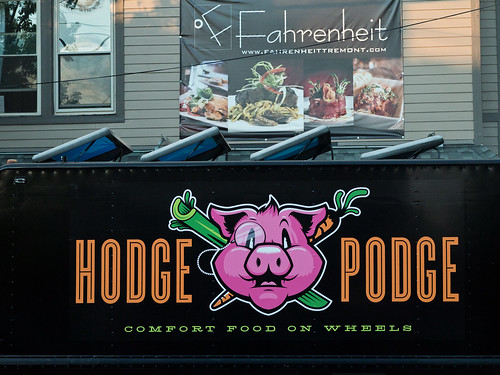Food Truck Concepts: What Works and What Doesn’t
Some food trucks hit the streets and soon become icons for their cities. Others go out of business before that cool paint job on the side of the truck gets dry. What makes the difference? Here are the dos and don’ts to follow when creating your cool new food truck concept.
1. Do Keep It Simple

Image via Flickr by Edsel L
People are busy, and this is perhaps most true for patrons of food trucks. Food trucks serve customers on their hectic lunch breaks, during crowded concerts, and at exciting places like festivals. The customers who enjoy your food do want to visit you again, so choose a name that’s easy to remember and recognize. Rhyming words, plays on words and phrases, and simple one word names are perfect.
Simple food truck names also help you in the design of your truck’s exterior. Your designer would be hard pressed to get a long, complicated name on your truck, along with logos and pictures to let customers know what’s waiting for them inside. The shorter the name of the truck, the bigger you can make the lettering, and the more room you have for adding cool graphics and signage for specials and announcements.
2. Don’t Overreach
You are what you are, no more and no less. Trying to specialize in 15 different menu items doesn’t give you an identity with your customers, makes it hard to stock the truck with ingredients, and convolutes any name you might come up with. Craft a name that makes it instantly clear what customers can expect when they approach the window.
Not overreaching, however, doesn’t mean don’t be creative. Choose a food niche, and play with all kinds of terms and phrases that could be used to make the food sound fun. Or, play around with your own name and how it rhymes with a food you’re offering. You can also go with a bizarre niche, such as the Gory Gourmet which serves gourmet foods with a Walking Dead zombie theme in London. Niches and gimmicks are great; convoluting your message is bad.
3. Do Be Unique
The more unusual the name, the more you stand out. But this has to be balanced with the first rule, keep it simple enough for customers to get a handle on. Research other food truck names, both local and worldwide. Maybe some of these names will spark your imagination in turning a pun or tweaking a phrase. The more unique your product offerings are, the more creative you can get when naming your food truck.
Play around with the spelling of words. Can you turn an “f” into “ph” or perhaps add an “e” to the end for a foreign sounding name? Create a theme for your truck, such as outer space, animals, or a popular TV show or movie. If you can work a theme into your food truck concept, it gives you better options for naming the truck. Avoid trendy names that will be outdated in a few years. For example, Dr. Who and Star Wars are still relevant and recognizable. Nobody cares about Beanie Babies anymore. (Which is a shame, because Beanie Babies’ Burritos is actually a good food truck name, wide open with menu possibilities.)
4. Don’t Try to Become Something You’re Not
When attempting to create a concept for a food truck, don’t come up with something that isn’t sustainable or isn’t exactly what you want to do. For instance, if you want to be able to offer beefy stews sometime, don’t try to start a vegan or vegetarian truck. Only start something that you’ll be seriously interested in sticking with over time.
It’s a great idea to cater to specific dietary needs, however. Good concepts include the only diabetic friendly food truck in town, or the only one offering gluten-free pastries and breads. Think about all the special diets people need to or want to follow, including low sodium foods, non dairy (for lactose intolerant customers), vegan and vegetarian cuisine, low-calorie, fat-free, high protein (for building muscle mass), low carb, and paleo diets. Just make sure it’s something you’ll be interested in continuing, because once you start offering pork at your kosher food truck, you’ll lose your customer base as well as your unique niche.
5. Do Choose a Name That Conveys What You Offer
If you specialize in kosher hot dogs, or low-fat yogurt, make this clear in your name, as well as the design of the truck’s exterior. Nanna’s Nuggets is ideal if you specialize in chicken nuggets, but it won’t help solidify your niche if the nuggets are baked, not fried, and this is your key selling point. Consider something more specific, such as Nanna’s No-Fry Nuggets, which will convey everything special about your product.
Many times, the only chance a food truck has to lure the customers they are looking for is by catching them in the instant they scan their eyes across you and your competitors. What’s going to grab their attention and hold their focus long enough to convince them you’re what they’re looking for? Bright colors, catchy names, and neat graphics are your biggest assets here.
6. Don’t Ignore Feedback from Others
You like your idea, and you don’t really want to hear what’s wrong with it. That’s understandable, but it’s also negligent. Your critics can sometimes be your best assets. Toss your ideas around to your friends and family. Of course, don’t announce it to everyone around, or your best idea is likely to wind up on the side of someone else’s food truck. You can even conduct a small focus group to see how your ideas are received.
What may seem cute to you might be offensive to segments of the population. The point of getting the opinion of others is to avoid this pitfall. Does the theme or name seem insensitive to certain people? Is the title or slogan of the food truck unappetizing? Does it simply fail to grab and hold people’s interest? Get the ideas of others, and don’t be an ostrich when it comes to receiving feedback.
Once you’ve picked a theme and name, stick with it. Changing confuses customers, and you’ll never achieve the brand recognition that fuels food truck businesses over time. Likewise, if you’ve carefully chosen your theme and name, it won’t be outdated in a few years.
What are your dos and don’t of food trucks? Share your thoughts in the comments below.
